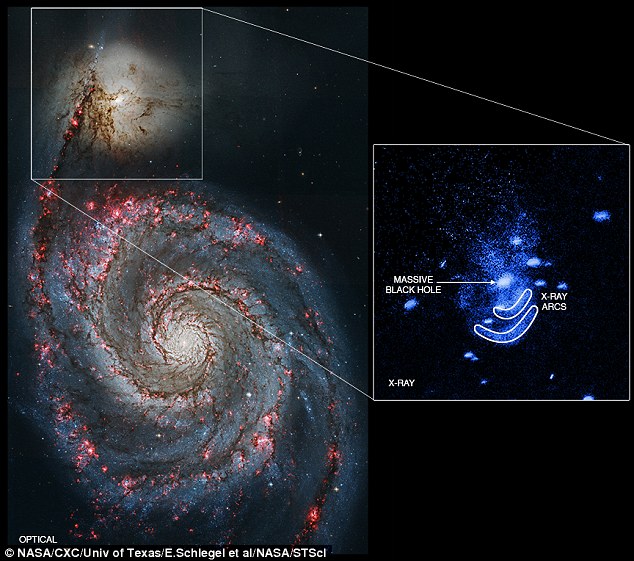
The supermassive core at the centre of the nearby galaxy NGC5195 (pictured at the top of the Whirlpool galaxy, the larger spiral galaxy) has been found to be ‘burping’ X-ray emitting blasts of hot gas. This has swept up the cooler hydrogen gas at the centre of the galaxy into two arcs shown in inset blue X-ray image.
Posted by P. LaViolette, February 5, 2016
The Whirlpool Galaxy (M51) is another example of a galactic core fission event that resulted in the production of the dwarf satellite galaxy NGC 5195 which is seen at the upper left in the above diagram. This pair are located quite close to us about 26 million light years away. The conventional interpretation based on the standard big bang paradigm is that NGC 5195 was gravitationally captured by the Whirlpool galaxy. However, the Whirlpool galaxy, with its distinctive spiral shape, exhibits a striking lack of tidal disruption. Moreover its alignment with one of M51’s spiral arms cannot be passed off as just coincidence. It is as if this spiral arm forms a trailing stellar bridge linking this daughter galaxy’s supermassive with its larger parent galaxy from whose center it emerged long, long ago.
Over the millions of years since its expulsion from M51’s core, the supermassive core at the center of NGC 5195 has apparently had a chance to expel large amounts of matter and spawn its own diminutive galaxy of stars. Now, evidence has been found that NGC 5195 is indeed expelling matter and building up its own galactic disc. A group of astronomers at the January 6th American Astronomical Society meeting in Florida announced their discovery of two distinct arcs of X-ray emitting hot gas observed using NASA’s Chandra X-ray telescope; see arcs in the X-ray diagram inset above. They propose that the arcs were formed by two outbursts from the dwarf galaxy’s core, one occurring about 3 million years ago and the other about 3 to 6 million years ago. They suggest that these swept up cooler hydrogen gas that resided further in towards the core. If I am not mistaken, these arcs are very good evidence for the occurrence of superwaves in nearby galaxies, ones that are apparently involved in creating a dwarf galaxies spiral arms.
Commenting on their findings, one of the group’s team members, Dr Marie Machacek, stated “This shows that black holes can create, not just destroy.” Ignore here the word “black hole” which astronomers continue to use. As I have stated in my journal papers and books over the past 31 years, black holes do not exist; only energy producing/emitting, supermassive cores. If you wish to learn more about the black hole fallacy, put “black hole” in the search box on this site. Anyway, this indicates that at least some astronomers are starting to realize that galactic cores are indeed matter/energy expelling sources. Their belief that they power themselves solely by gobbling matter is an unsubstantiated hypothesis, as there is no way that matter can be consumed by an active galactic core. The energy coming out is so fierce that it fragments and blows outward anything that comes near it. The evidence for core expulsion, however, is pervasive and observationally based.
So this group’s finding that the core of NGC 5195 is seen to be expelling matter fits with the scenario proposed here that NGC 5195 is in the process of growing and forming stars, and not in the process of having them tidally stripped off. It also generally supports the idea that the core of NGC 5195 was once expelled through a similar outburst event that once occurred in the core of its parent galaxy M51.
Been arguing about this one as well.
I’ve found no matter where you argue, if it’s on social networks, expect tons of trolls and shills. They can be quite venomous. 🙂